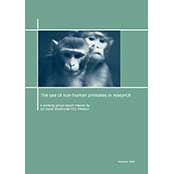A working group report chaired by Sir David Weatherall FRS FMedSci
Contents
Abbreviations and acronyms 3
1 Summary 5
Recommendations 8
2 Introduction and methods of working 11
2.1 Background, objectives and timeliness 11
2.2 Scope and process of the report 14
3 Current position of non-human primate research 19
3.1 Introduction 19
3.2 A global overview 19
3.3 UK legal requirements 21
3.4 UK non-human primate use 24
3.5 Main fields of non-human primate research, excluding toxicology 31
3.6 Other uses of non-human primates 32
3.7 Discussion 32
4 Investigation into the scientific basis for current non-human primate research 35
4.1 Background 35
4.2 Why does the use of animals in biological and medical research vary so much between
different fields? 35
4.3 Can research on humans replace work on non-human primates? 36
4.4 The distinction between basic and applied research 37
5 Infectious (communicable) disease 39
5.1 Introduction 39
5.2 HIV/AIDS 40
5.3 Malaria 47
5.4 Tuberculosis 50
5.5 Other infectious diseases 52
5.6 Discussion 56
6 Neuroscience 59
6.1 Introduction 59
6.2 Connectivity, neurons and circuits 60
6.3 Comparisons of vertebrate, non-human primate and human brains 62
6.4 Neuroscience research tools: direct and indirect techniques 64
6.5 Neuroscience research tools: observational and interventional techniques 67
6.6 The use of non-human primates in fundamental neuroscience research 68
6.7 The use of non-human primates in clinical neuroscience research 73
6.8 Brain-machine interfaces 81
6.9 Discussion 82
7 Other research areas 85
7.1 Introduction 85
7.2 Reproductive biology 85
7.3 Gender comparative studies relating to common human diseases 87
7.4 Fetal development and common disease in adult life 88
7.5 Ageing 89
7.6 Discussion 90
8 Drug discovery and development 91
8.1 Introduction 91
8.2 Regulations and regulatory agencies 91
8.3 Non-human primates and drug safety 91
8.4 Second species selection in regulatory toxicology 92
8.5 Non-human primates, regulatory toxicology and the 3Rs. 95
8.6 Discussion 97
9 Alternatives to the use of non-human primates for medical research and toxicology 99
9.1 Introduction 99
9.2 Molecular and cell biology approaches 99
9.3 Computer modelling and systems biology: in silico approaches 103
9.4 Human studies 104
9.5 Discussion 107
10 Welfare issues 109
10.1 Introduction 109
10.2 Breeding 110
10.3 Housing 112
10.4 Imported animals and transport 114
10.5 Welfare during the practice of research 115
10.6 Discussion 119
11 Ethics 123
11.1 Introduction 123
11.2 Moral status and legal personality 123
11.3 Moral intuitions 124
11.4 Costs and benefits 125
11.5 Ethics and research involving non-human primates 126
11.6 Discussion 129
12 Discussion 131
12.1 A polarised debate 131
12.2 The pace and unpredictability of biomedical research 131
12.3 A lack of integration in non-human primate research 131
12.4 The anecdotal nature of some of the issues in this report 132
12.5 The need for wider public debate 132
12.6 The future of UK non-human primate research 133
12.7 Future action based on this report 134
13 Conclusions and recommendations 135
Appendix I Report preparation 143
Appendix II List of consultees and respondents to the call for evidence 145
